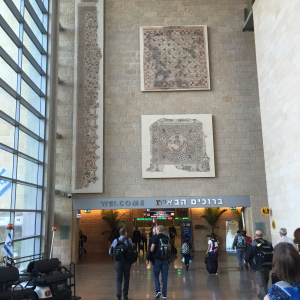Sunday, April 29 ~ Steve Hammond

What a thrill and what a blessing to be in the Holy Land! After 24 hours of travel our group of pilgrims checked into The Holy Land Hotel in Bethlehem, in the Israeli-occupied “West Bank” of the ancient lands called Palestine, or Israel, depending on who you ask. Let’s just call it Israel-Palestine, or, perhaps, a land called Holy.
The hotel hosts mainly Christian pilgrims and conferees in Bethlehem. We dine alongside a group of Eastern Orthodox Christians in the common dining hall, which is decked with banners distinctly Orthodox in character. Bethlehem presents a rich and fascinating mix to the visitor, one of Palestinian Christians and Muslims, Christian pilgrims from around the world, and Jewish settlers on a nearby hill and behind a wall of separation, on the other side of the checkpoints controlling entry and egress.
What a joy this morning to be welcomed to worship at Christmas Lutheran Church in Bethlehem! A small but elegant church, built in the latter 19th century, with distinctive Holy Land stone and beautiful stained glass, it offered coolness and shade from the already strong sun. The service was conducted primarily in Arabic, with occasional supplementary English, and all were invited to sing and respond collectively in their own language. The Pilgrims were invited to visit and have a small cup of Arabic coffee afterward.
Soon, though, we were off to start the planned excursion to Qumran and the Dead Sea. The drive along the east side of Jerusalem offered dramatic contrast between the occupied territory and Israeli settlements (the latter neat and orderly, the former obviously poorer), and between the green-tinged scrub of the hills on the west and the seemingly barren desert starting abruptly just a few miles east of Jerusalem.

Bedouins, threatened with imminent demolition of their homes
We traveled downward, from 2500 feet at Jerusalem to the lowest point on earth, the Dead Sea, 1412 feet below sea level (it’s hot down there!). We passed numerous Bedouin camps and saw a few Bedouin herding goats, sheep, and cattle. The hillsides are laced with goat paths and one wonders how the sparse vegetation can feed even the widely spread flocks.

Cave 4 at Qumran, where some of the Dead Sea Scrolls were found

Qumran, Dead Sea, and Jordan in the distance
Qumran is notable mainly for the austere landscape featuring washes and rugged, reddish cliffs showing numerous caves, some obviously carved by human hands. The land seems to offer little distance between human and God.
The Dead Sea is extremely salty and offers a novel bathing experience among a good-natured, international crowd of tourists.

St. George’s Monastery at Wadi Qelt
On the way back to Bethlehem we took a side trip to see St. George’s monastery, set in cliffs above the gorge of the Wadi Qelt, along which runs the ancient road to Jericho.
Though eager to see more sights and places, we particularly look forward to meeting the “living stones,” the people who live in and cherish this Holy Land.







